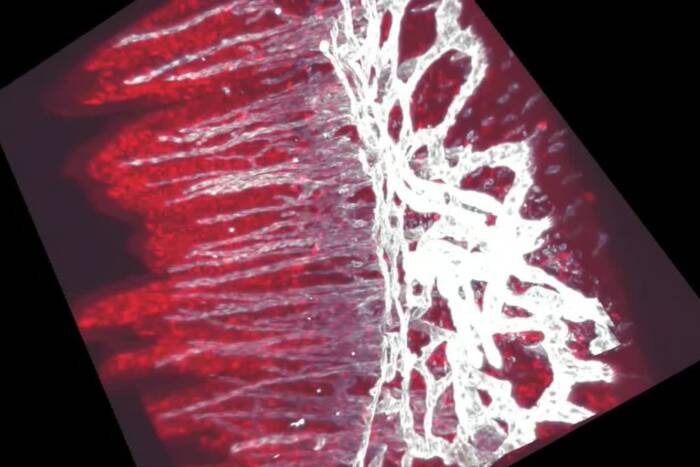Bigger data, bigger opportunities: Meet Rockefeller’s new chief information officer
by Eva Kiesler, managing editor
According to some estimates, more than 90 percent of information created by humanity has been generated only in the last couple of years. The need for new technologies to handle large and complex data sets is particularly evident in the area of bioscience, where modern research tools such as DNA sequencers and imaging systems are churning out an ever-increasing torrent of new material. And increasingly, scientists depend on computational tools and methods to find meaning in this mass of information.
“It’s an exciting time for those of us who work in information technology and bioinformatics, as we’re increasingly able to support scientists in their work,” says Rockefeller’s chief information officer, Anthony Carvalloza.
Since joining the university five months ago as the new head of Information Technology (IT), his main goal has been to build an environment to help scientists store, analyze, and share scientific information, and help the department develop additional analytical expertise and tools.
The top choice for the job
A technology executive with robust experience building IT and informatics services for academic and for-profit research institutions, Mr. Carvalloza knows a lot about how to streamline computing and bioinformatics services to better serve the needs of biomedical scientists. For example, in his previous job as IT and informatics director at the Scripps Research Institute, with campuses in La Jolla, California, as well as in Jupiter, Florida, he established a bioinformatics core that helped researchers analyze and visualize scientific data, and he and members of his team actively participated in a number of research projects.
“Anthony was the top choice of our search committee and he is a terrific addition to Rockefeller,” says Chief of Staff and Vice President Timothy O’Connor. “Having successfully supported the needs of bioscientists in a variety of settings, he brings considerable new knowledge and experience that will be enormously helpful as we develop and expand our IT services.”
“One of the things that attracted me to Rockefeller, apart from its outstanding reputation as a world-class bioscience institution, is the focus on minimally bureaucratic operations,” Mr. Carvalloza says. “People here are able to get things done, and the IT department has a great culture of service and support, which we will maintain as we add new technologies and skills.”
From cyber security to biomedical science
Mr. Carvalloza’s IT career began with an early fascination with the power of computing. As a student in information management at Syracuse University in New York—from where he graduated summa cum laude—he says he was “intrigued with the idea of using machines as an extension of the brain to solve problems the human mind can’t approach on its own.”
He originally considered a career fighting hackers and cyber terrorists, perhaps working for the National Security Agency, or a similar organization devoted to cryptography and security. But while doing an internship at a pharmaceutical company, his focus began to shift. “I became very curious about how computers might be used to solve complex problems in biology and medicine,” he says.
Mr. Carvalloza worked for a few years as a senior systems analyst at Merck Research Labs in Rahway, New Jersey. During his time at Merck, and later at Scripps, he provided highly specialized support for navigating and analyzing many types of scientific data, including output from next-generation genomic sequencing, proteomics, and high throughput drug screening.
Investments in high-performance computing and informatics
At Rockefeller, Mr. Carvalloza’s immediate priorities include acquiring new equipment for high-performance computing. Rockefeller recently obtained a new data storage system that he says will bring the university “into the petascale era.” (A petabyte is 1,000 terabytes, or close to 225,000 DVDs.)
A new director of high-performance computing and applications will start this month, and will help ready the new system for use by the beginning of next year. “Currently, many of our labs are working with mid-sized data sets, but new investments in research technology will soon bring us to a point where investigators are handling enormous data sets,” Dr. Carvalloza says. “By making these investments now we will be well prepared to tackle bigger scientific questions.”
For example, using Rockefeller’s recently acquired cryo-electron microscopes, scientists in several labs are already capturing unprecedented amounts of structural information at the scale of molecules, atoms, and electrons.
In addition, the establishment of a bioinformatics resource group will provide access to expertise in the latest analytical methods, and will work to develop software tools that will make it possible to gain new knowledge from existing data sets.
Safe and efficient technologies
Information security is another area of focus. For example, the IT team recently implemented two-factor authentication. “This security measure is one of the easiest ways to protect against some of the most common and most damaging assaults,” Mr. Carvalloza notes. “For instance, a recent breach at the University of Virginia occurred through a compromised password, the very type of weakness two-factor authentication is meant to address.”
In addition, Mr. Carvalloza’s office will consider how to streamline some of the university’s IT operations. “We are exploring how rapid advances in cloud technologies, big data tools, and modern network infrastructure can help us deliver the highest standard of technology support at the university.”



